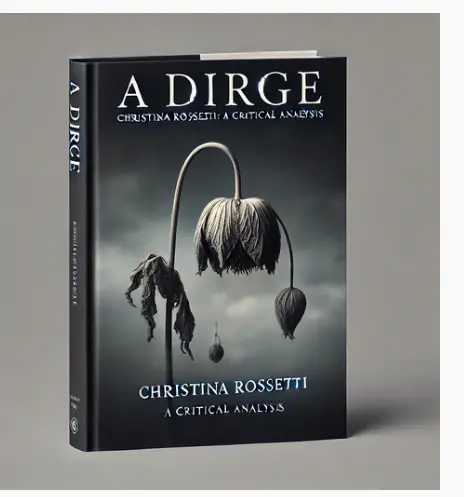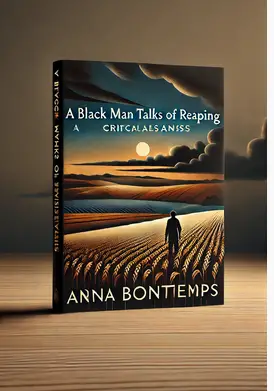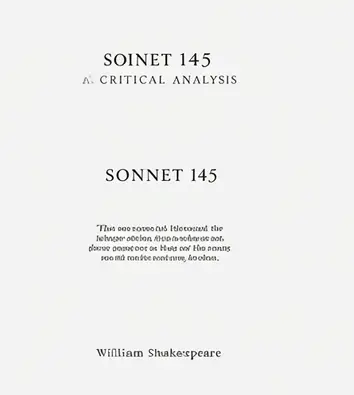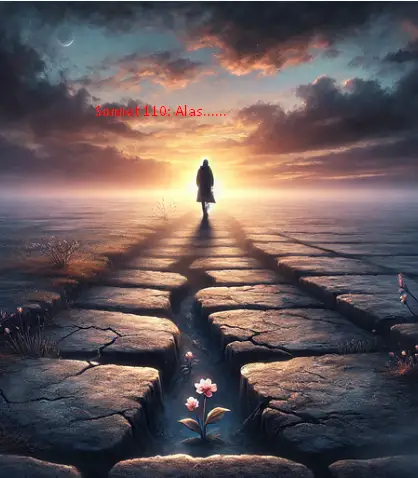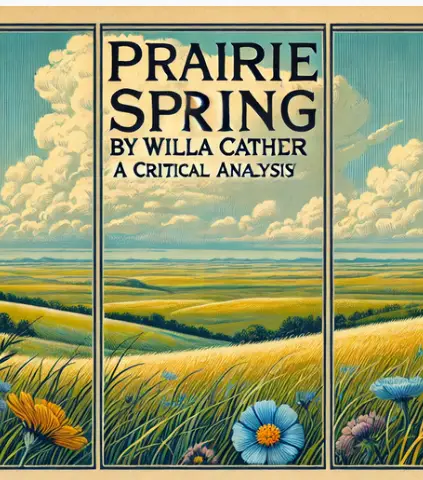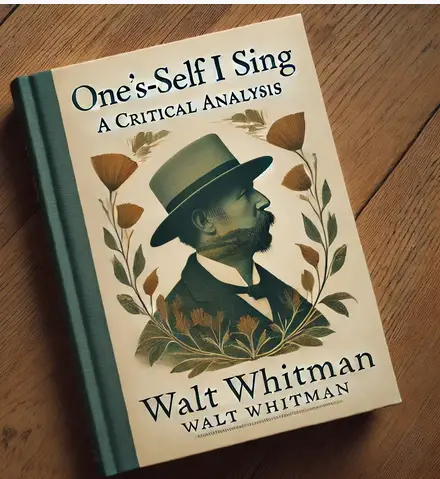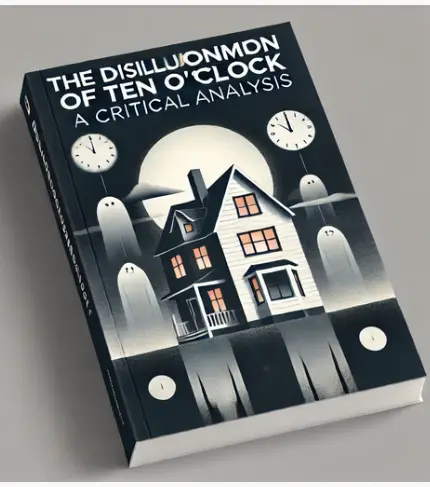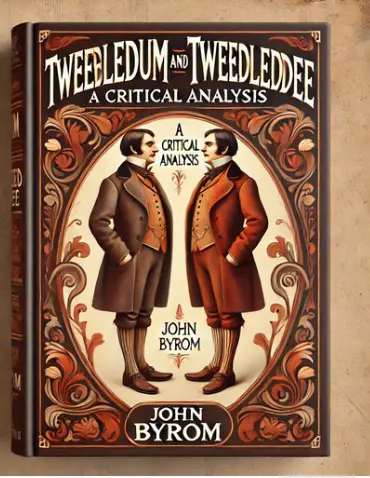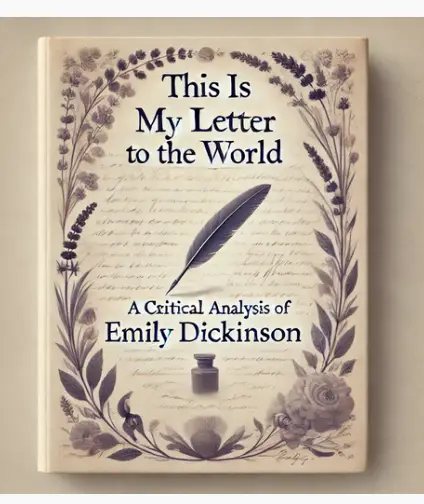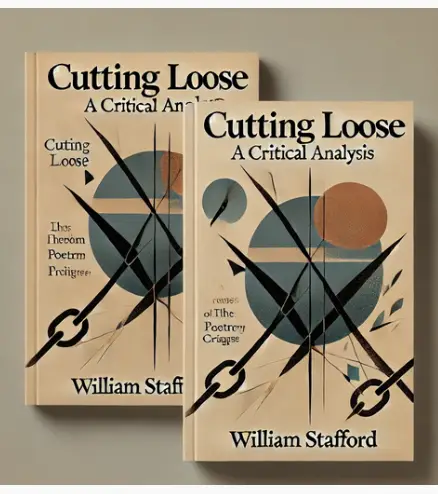
Introduction: “Cutting Loose” by William Stafford
“Cutting Loose” by William Stafford first appeared in his 1998 collection The Way It Is: New and Selected Poems. This poem exemplifies Stafford’s hallmark qualities of simplicity, introspection, and a deep connection to the natural world. It explores themes of freedom, self-liberation, and the fluidity of life’s journey. Through its gentle yet profound language, Stafford invites readers to embrace uncertainty and let go of rigid structures, suggesting that release can lead to discovery and renewal. The poem’s central message revolves around the idea of allowing oneself to flow freely with the currents of life, finding strength in vulnerability and openness.
Text: “Cutting Loose” by William Stafford
Sometimes from sorrow, for no reason,
you sing. For no reason, you accept
the way of being lost, cutting loose
from all else and electing a world
where you go where you want to.
Arbitrary, a sound comes, a reminder
that a steady center is holding
all else. If you listen, that sound
will tell where it is, and you
can slide your way past trouble.
Certain twisted monsters
always bar the path – but that’s when
you get going best, glad to be lost,
learning how real it is
here on the earth, again and again.
Annotations: “Cutting Loose” by William Stafford
| Line | Annotations |
| Sometimes from sorrow, for no reason, | Poetic Device: Alliteration in “sometimes” and “sorrow” emphasizes emotional spontaneity. Theme: Sudden and inexplicable emotional shifts. Tone: Reflective and contemplative. |
| you sing. | Rhetorical Device: Simple, direct statement that suggests emotional release. Sound Device: The abruptness of the period after “sing” mirrors the unexpected nature of joy. |
| For no reason, you accept | Repetition: “For no reason” reiterates the unpredictability of human emotions. Theme: Acceptance without justification; surrendering to the moment. |
| the way of being lost, cutting loose | Metaphor: “The way of being lost” suggests embracing uncertainty. Poetic Device: “Cutting loose” metaphorically conveys breaking free from constraints. |
| from all else and electing a world | Diction: The choice of “electing” emphasizes the act of conscious decision-making. Theme: Autonomy and personal freedom. |
| where you go where you want to. | Rhetorical Device: The repetition of “where” mimics the free-flowing nature of the world being described. Theme: Self-direction and liberation. |
| Arbitrary, a sound comes, a reminder | Sound Device: The word “arbitrary” echoes randomness. Symbolism: The “sound” symbolizes guidance or an inner voice. Theme: Life offers unexpected clues. |
| that a steady center is holding | Metaphor: “Steady center” symbolizes stability or a core of calm amidst chaos. Theme: Inner balance in the face of unpredictability. |
| all else. If you listen, that sound | Repetition: The second mention of “sound” reinforces its significance. Rhetorical Device: Conditional “If you listen” invites the reader to reflect on the importance of attention. |
| will tell where it is, and you | Enjambment: The line flows into the next, mimicking the continuous nature of life’s guidance. Theme: Intuition and self-awareness. |
| can slide your way past trouble. | Metaphor: “Slide” implies moving through challenges effortlessly. Theme: Avoidance of obstacles through attentiveness to inner guidance. |
| Certain twisted monsters | Symbolism: “Twisted monsters” represent inner fears or external challenges. Poetic Device: Connotation of “twisted” suggests complexity and distortion. |
| always bar the path – but that’s when | Juxtaposition: The contrast between challenges (“bar the path”) and progress (“that’s when you get going best”) highlights growth through adversity. |
| you get going best, glad to be lost, | Irony: The joy in being “lost” contrasts with conventional views on direction and certainty. Theme: Discovery and freedom through disorientation. |
| learning how real it is | Tone: Philosophical. Theme: Experience and presence lead to deeper understanding of reality. |
| here on the earth, again and again. | Repetition: “Again and again” emphasizes cyclical learning. Symbolism: “Earth” represents grounding in the physical world. Theme: Repeated encounters with reality and renewal. |
Literary And Poetic Devices: “Cutting Loose” by William Stafford
| Device | Example | Explanation |
| Alliteration | “Sometimes from sorrow” | The repetition of the initial ‘s’ sound emphasizes the melancholic tone and emotional spontaneity. |
| Anaphora | “For no reason, you sing. For no reason, you accept” | The repetition of the phrase “For no reason” at the start of two lines reinforces the poem’s focus on spontaneity and unexplainable emotions. |
| Assonance | “you sing” | The repetition of the vowel sound ‘i’ in “you” and “sing” creates internal harmony within the line. |
| Caesura | “where you go where you want to.” | The use of a natural pause between “go” and “where” breaks the flow and mimics the reflective tone, emphasizing personal freedom. |
| Connotation | “Twisted monsters” | “Twisted” connotes distortion, confusion, and difficulty, adding depth to the metaphor of inner fears and external obstacles. |
| Enjambment | “If you listen, that sound / will tell where it is” | The thought continues across two lines, mirroring the ongoing, flowing nature of life and guidance. |
| Epiphora | “a sound comes, a reminder / that a steady center is holding / all else.” | The repetition of “a” at the beginning of these lines adds rhythm and continuity, focusing on the concept of inner stability. |
| Hyperbole | “Certain twisted monsters always bar the path” | “Always” is an exaggeration, emphasizing the inevitability of encountering difficulties in life. |
| Irony | “Glad to be lost” | It is ironic to find joy in being lost, as it contrasts with the usual fear or discomfort associated with losing one’s way. |
| Juxtaposition | “Monsters bar the path – but that’s when you get going best” | The contrast between obstacles and thriving highlights the idea that challenges often bring out the best in a person. |
| Metaphor | “Cutting loose” | The phrase symbolizes the act of freeing oneself from restrictions and embracing uncertainty. |
| Metonymy | “A sound comes” | The “sound” represents intuition or an inner voice that guides the speaker through life’s complexities. |
| Paradox | “Glad to be lost” | A paradox, as being lost is typically associated with confusion, but here it brings joy and discovery. |
| Personification | “Monsters always bar the path” | The “monsters” are personified as obstacles or challenges in life that actively block the speaker’s progress. |
| Repetition | “For no reason” | The phrase is repeated twice to emphasize the speaker’s sense of spontaneity and acceptance of life’s unpredictability. |
| Rhetorical Question | “If you listen, that sound will tell where it is?” | Though not directly phrased as a question, the conditional “If you listen” prompts a reflective inquiry into whether the reader is paying attention to life’s subtle signals. |
| Simile | “Slide your way past trouble” | Though subtle, “slide” evokes an image of effortless movement, much like sliding on a surface, conveying ease in overcoming difficulties. |
| Symbolism | “Steady center” | The “steady center” symbolizes inner balance and stability, even in the face of chaos. |
| Theme | “Learning how real it is here on the earth” | The recurring theme of reality, learning, and renewal permeates the poem, focusing on life’s unpredictability and the discovery of self. |
| Tone | “Learning how real it is here on the earth, again and again” | The reflective tone highlights the speaker’s philosophical outlook on life and the constant rediscovery of reality through experience. |
Themes: “Cutting Loose” by William Stafford
- Freedom and Liberation
- One of the central themes in “Cutting Loose” is the idea of freedom and liberation, both physically and emotionally. The speaker describes “cutting loose from all else” (line 3), indicating a conscious decision to break away from societal or personal constraints. This act of freedom is further emphasized when the speaker “elect[s] a world / where you go where you want to” (lines 4-5), highlighting the liberation that comes from choosing one’s own path. The metaphor of “cutting loose” symbolizes breaking free from the expectations and norms that can confine individuals, suggesting that true liberation comes from embracing a sense of directionless freedom.
- Embracing Uncertainty
- Stafford’s poem also explores the theme of embracing uncertainty and being comfortable with being lost. The speaker suggests that sometimes you must “accept / the way of being lost” (lines 2-3), which indicates an acceptance of the unknown. Rather than fearing disorientation, the speaker finds empowerment in it, claiming that being lost allows them to “slide your way past trouble” (line 9). “Cutting Loose” portrays uncertainty not as something to avoid, but as an essential part of life’s journey, where letting go of rigid expectations allows for personal growth and discovery.
- Inner Guidance and Intuition
- Another theme in “Cutting Loose” is the importance of inner guidance and intuition. The speaker refers to “a steady center” (line 7), which symbolizes an internal compass that provides stability amidst chaos. The “sound” that emerges “arbitrarily” (line 6) is a metaphor for the intuitive signals we receive, which, if listened to, can help guide us “past trouble” (line 9). This theme underscores the idea that while life may be unpredictable, our own intuition can provide the direction and clarity needed to navigate through challenges.
- Overcoming Obstacles
- The theme of overcoming obstacles is also prominent in “Cutting Loose”. The speaker acknowledges that “Certain twisted monsters / always bar the path” (lines 10-11), representing the inevitable challenges that everyone faces. However, instead of succumbing to fear or defeat, the speaker asserts that “that’s when you get going best” (line 12), suggesting that obstacles can serve as catalysts for growth and momentum. The poem encourages readers to see difficulties not as barriers but as opportunities to learn, adapt, and move forward, reinforcing the resilience of the human spirit.
Literary Theories and “Cutting Loose” by William Stafford
| Literary Theory | Explanation | References from “Cutting Loose” |
| Existentialism | Existentialism emphasizes individual freedom, choice, and the inherent uncertainty of life. The theory suggests that people must create their own meaning in a world without intrinsic purpose. | The speaker embraces uncertainty: “you accept / the way of being lost” (lines 2-3). The notion of “cutting loose” (line 3) reflects an existential act of choosing one’s own path and finding freedom in embracing the unknown. |
| Transcendentalism | Transcendentalism focuses on self-reliance, intuition, and a connection to nature as sources of truth. It encourages individuals to trust their inner voice over societal conventions. | The poem reflects Transcendentalist ideals in its call to listen to inner intuition: “If you listen, that sound / will tell where it is” (lines 8-9), and its focus on freedom and nature, symbolized by “cutting loose” (line 3). |
| Psychoanalytic Criticism | Based on Freud’s theories, psychoanalytic criticism explores the unconscious mind, inner conflicts, and the impact of repressed desires and fears on human behavior. | The “twisted monsters” (line 10) can be seen as symbolic of repressed fears or inner psychological conflicts that “bar the path,” yet overcoming these leads to growth: “you get going best” (line 12). |
Critical Questions about “Cutting Loose” by William Stafford
- What does “cutting loose” symbolize in the poem?
- In “Cutting Loose”, the act of “cutting loose” symbolizes breaking free from societal expectations, personal limitations, and the need for certainty. It represents a conscious decision to embrace the unknown and trust in one’s own intuition and inner guidance. The speaker mentions “electing a world / where you go where you want to” (lines 4-5), which reinforces the idea of personal autonomy and self-determination. By “cutting loose,” the speaker liberates themselves from external constraints and allows for a more fluid, spontaneous experience of life, where freedom and self-discovery become possible.
- How does the poem present the concept of uncertainty?
- “Cutting Loose” presents uncertainty not as something to be feared, but as a natural and even desirable aspect of life. The speaker states, “you accept / the way of being lost” (lines 2-3), suggesting that embracing uncertainty can lead to personal growth and understanding. The poem frames uncertainty as an opportunity to explore new paths and discover inner strength, as seen when the speaker explains how being lost allows them to “slide your way past trouble” (line 9). Rather than resisting uncertainty, the poem advocates for accepting it as an integral part of the human experience, where flexibility and openness lead to deeper insight.
- What role does intuition play in the poem?
- Intuition plays a crucial role in “Cutting Loose”, acting as an inner guide that helps the speaker navigate through the complexities of life. The “steady center” (line 7) symbolizes the core of stability and calm that remains constant, even when external circumstances are chaotic. The poem suggests that if one listens carefully to this inner guidance, it will “tell where it is” (line 9) and help in moving past difficulties. This focus on intuition emphasizes the importance of trusting one’s inner voice over external influences, as intuition provides clarity and direction in moments of uncertainty.
- How does the poem depict the challenges or “monsters” that bar the path?
- In “Cutting Loose”, the “twisted monsters” (line 10) represent the challenges and fears that everyone inevitably faces in life. These obstacles are described as figures that “always bar the path” (line 11), signifying the unavoidable difficulties that arise. However, the speaker presents these monsters not as insurmountable but as catalysts for personal growth. It is “when you get going best” (line 12) that one thrives in the face of adversity. The poem portrays challenges as opportunities for learning and gaining strength, reinforcing the idea that facing difficulties leads to deeper understanding and self-discovery.
Literary Works Similar to “Cutting Loose” by William Stafford
- “The Road Not Taken” by Robert Frost: Like “Cutting Loose”, this poem explores themes of personal choice, freedom, and the unpredictability of life’s journey, emphasizing the significance of individual decisions.
- “Song of the Open Road” by Walt Whitman: Similar to “Cutting Loose”, Whitman’s poem celebrates the freedom of the open road, personal liberation, and embracing uncertainty with a sense of adventure and self-reliance.
- “Wild Geese” by Mary Oliver: This poem, like “Cutting Loose”, encourages letting go of societal expectations and trusting in one’s natural instincts and intuition as a way to find peace and freedom.
- “Invictus” by William Ernest Henley: Both “Invictus” and “Cutting Loose” emphasize inner strength, resilience in the face of challenges, and the belief in one’s ability to navigate life’s difficulties independently.
- “I Wandered Lonely as a Cloud” by William Wordsworth: Like “Cutting Loose”, this poem reflects on moments of introspection, freedom, and finding solace and self-discovery through nature and solitary experiences.
Representative Quotations of “Cutting Loose” by William Stafford
| Quotation | Context | Theoretical Perspective |
| “Sometimes from sorrow, for no reason, you sing.” | This line opens the poem, suggesting that emotional responses can arise spontaneously, without logical cause. | Existentialism: Focuses on the unpredictability of emotions and the spontaneous creation of meaning. |
| “For no reason, you accept / the way of being lost.” | The speaker embraces uncertainty and chooses to let go of rigid expectations, accepting being lost as part of life. | Transcendentalism: Advocates trusting the self and natural intuition over rational thought. |
| “cutting loose from all else and electing a world” | The speaker deliberately chooses personal freedom and self-determination, metaphorically breaking free from external constraints. | Existentialism: Highlights individual choice and the creation of one’s own path. |
| “where you go where you want to.” | The speaker emphasizes autonomy and the ability to navigate life freely without being bound by external expectations. | Individualism: Centers around self-reliance and the importance of personal freedom. |
| “Arbitrary, a sound comes, a reminder” | The “sound” represents an intuitive inner voice or external signal that appears without warning, offering guidance. | Psychoanalytic Criticism: The “sound” can symbolize unconscious desires or intuition guiding behavior. |
| “that a steady center is holding all else.” | This refers to the inner stability or balance that remains constant despite the chaos or uncertainty in life. | Transcendentalism: Suggests a connection to an inner, stable core that transcends external circumstances. |
| “If you listen, that sound / will tell where it is.” | The speaker advises paying attention to intuition or subtle signs that guide one through life’s difficulties. | Psychoanalytic Criticism: Listening to the unconscious or intuition for guidance in resolving inner conflicts. |
| “Certain twisted monsters always bar the path” | The “monsters” represent obstacles, fears, or challenges that the speaker encounters along the way. | Jungian Criticism: The “monsters” could symbolize archetypal fears or internal psychological conflicts. |
| “but that’s when you get going best” | The speaker finds that facing obstacles brings out the best in them, suggesting that challenges lead to personal growth and motivation. | Existentialism: Confronting adversity as an essential part of human experience and self-actualization. |
| “glad to be lost, learning how real it is” | The speaker embraces being lost and finds joy in the process, learning about the reality of life through direct experience. | Phenomenology: Focuses on lived experience and understanding reality through one’s own perspective. |
Suggested Readings: “Cutting Loose” by William Stafford
- Dick Barnes. “William Stafford.” The Hudson Review, vol. 54, no. 2, 2001, pp. 284–284. JSTOR, https://doi.org/10.2307/3852664. Accessed 24 Oct. 2024.
- COLES, ROBERT. “William Stafford’s Long Walk.” The American Poetry Review, vol. 4, no. 4, 1975, pp. 27–28. JSTOR, http://www.jstor.org/stable/27775006. Accessed 24 Oct. 2024.
- Lauber, John. “World’s Guest: William Stafford.” The Iowa Review, vol. 5, no. 2, 1974, pp. 88–100. JSTOR, http://www.jstor.org/stable/20158228. Accessed 24 Oct. 2024.
- Moore, Paula. “William Stafford’s Snowshoes.” Technical Communication, vol. 31, no. 2, 1984, pp. 48–48. JSTOR, http://www.jstor.org/stable/43086890. Accessed 24 Oct. 2024.
- Greiner, Charles F. “Stafford’s ‘Traveling through the Dark’: A Discussion of Style.” The English Journal, vol. 55, no. 8, 1966, pp. 1015–48. JSTOR, https://doi.org/10.2307/812727. Accessed 24 Oct. 2024.
